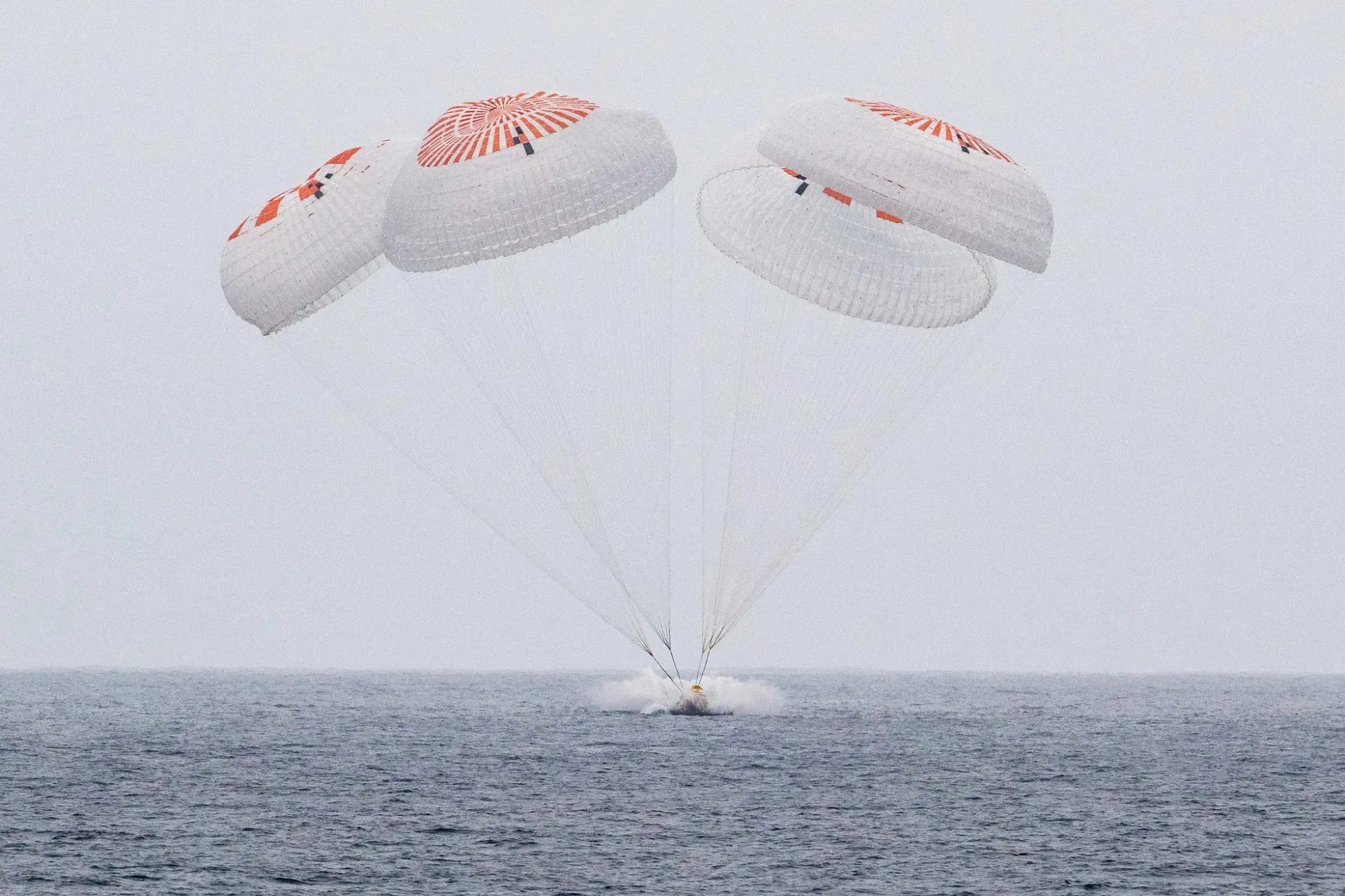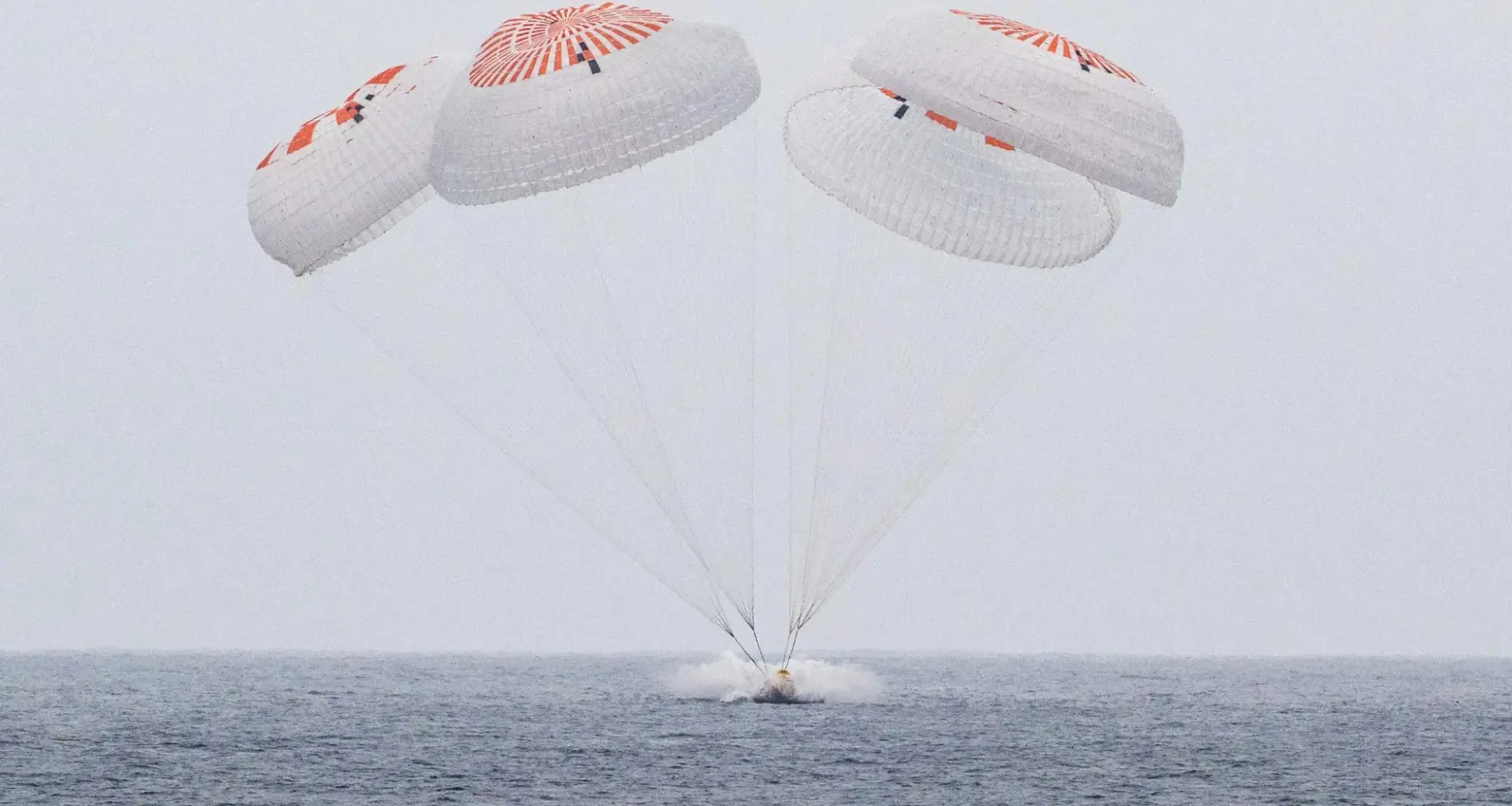
NASA and SpaceX’s Crew-10 astronauts splash down off the coast of California after spending almost five months aboard the International Space Station. Credit: NASA/Keegan Barber
NASA’s 10th Commercial Crew mission (Crew-10), utilizing SpaceX’s Dragon and Falcon 9, successfully concluded, returning a crew of astronauts from NASA, Roscosmos, and JAXA after a five-month mission aboard the ISS.
Crew-10 conducted numerous experiments focusing on material flammability, pharmaceutical production in space, lunar navigation systems, plant growth in microgravity, and astronaut health, including studies on SANS.
Crew-10’s return facilitated the homecoming of the Boeing Starliner crew (Williams and Wilmore) following unforeseen technical issues encountered during their mission, delaying Starliner’s operational certification.
Subsequent research by Crew-11 will build upon Crew-10’s findings, focusing on astronaut physiology, simulated moon landings, and improving re-entry comfort, while NASA continues to rely primarily on SpaceX for ISS crew transportation.
The latest astronaut crew conducting research on the International Space Station (ISS) returned to Earth on Saturday, marking the successful completion of NASA’s 10th Commercial Crew mission to the orbital laboratory.
The crew of NASA and SpaceX’s Crew-10 mission splashed down off the coast of California on Friday morning, ending its nearly five-month mission. During that time, astronauts from NASA, Roscosmos, and the Japan Aerospace Exploration Agency (JAXA) conducted dozens of experiments, demonstrated cutting-edge technologies, and completed a spacewalk.
Earlier this month, the astronauts passed the torch to their colleagues on the Crew-11 mission, who will complete the remaining research objectives of NASA’s Expedition 73 to the ISS. In late June and early July, they welcomed the crew of Axiom Space’s fourth private ISS mission, Axiom Mission 4.
“Our crew missions are the building blocks for long-duration, human exploration pushing the boundaries of what’s possible,” said interim NASA administrator Sean Duffy in a statement. “NASA is leading the way by setting a bold vision for exploration where we have a thriving space industry supporting private space stations in low Earth orbit, as well as humans exploring the Moon and Mars.”
Crew-10 in the books
NASA astronaut Anne McClain commanded the Crew-10 mission, making her second spaceflight and third spacewalk. It was the first NASA mission for pilot Nichole Ayers, a U.S. Air Force Academy graduate with over 1,400 flight hours as an instructor pilot and mission commander.
Crew-10 was also the spaceflight debut for Roscosmos’ Kirill Peskov, a former commercial airline pilot. Rounding out the crew was JAXA’s Takuya Onishi, who flew to the ISS in 2016. Onishi was the first Japanese astronaut to robotically capture Northrop Grumman’s autonomous Cygnus spacecraft and leads the team that operates Kibo, Japan’s ISS experiment module.
The astronauts, strapped into a SpaceX Dragon capsule, lifted off on the company’s Falcon 9 rocket on March 14, docking autonomously with the space station about 29 hours later. Their arrival allowed Boeing Starliner crewmembers Suni Williams and Butch Wilmore — who hung up his spacesuit for good last week — to return home after nearly nine months aboard the orbital laboratory.
McClain, Ayers, Peskov, and Onishi took part in dozens of experiments and demonstrations designed to improve prospects for future long-duration spaceflight.
They tested the flammability of materials for future spacecraft designs, hardware for producing pharmaceuticals in space, and a backup lunar navigation system for the Artemis moon missions. They also studied plant growth on orbit, the effects of microgravity on human bones, muscles, and eye structures, and a host of other topics relating to astronaut health and physiology. Crewmembers even provided blood samples for continuous monitoring.
Crew-11 astronauts Mike Fincke and Zena Cardman of NASA, Oleg Platonov of Roscosmos, and Kimiya Yui of JAXA, who arrived on August 2, will advance that work as NASA charts its first post-Apollo moon mission — and, potentially, future missions to Mars.
In addition to research on astronaut physiology — including spaceflight associated neuro-ocular syndrome (SANS), a condition reported by many ISS occupants upon their return — they will simulate moon landings before, during, and after the mission to gauge their performance in different gravity conditions. Some crewmembers will complete postflight surveys to track discomfort during the reentry phase, which according to NASA could inform the design of future lunar landing systems.
Commercial crew’s future
Through the Commercial Crew missions, NASA has maintained a continuous human presence on the ISS for more than 25 years. All 10 completed missions have relied upon SpaceX’s Dragon and Falcon 9, which also launched Crew-11. But they are not the only vehicles tied to the program.
Crew-10’s arrival facilitated the return of Williams and Wilmore, who flew up on Boeing Starliner’s inaugural crew flight test (CFT). NASA in 2014 awarded billions of dollars in contracts to both SpaceX and Boeing, seeking two Commercial Crew vehicles in case one of them experienced issues. While SpaceX has met the challenge with Dragon and Falcon 9, Boeing has struggled to produce, suffering years of delays and racking up more than $2 billion in losses.
The Starliner CFT launched in June 2024, and Williams and Wilmore were scheduled for an approximately eight-day ISS stay. However, NASA and Boeing engineers identified multiple postlaunch issues, including helium leaks and degraded thrusters. Ultimately, agency leadership opted to bring the Starliner crew home at the conclusion of Crew-10, and the spacecraft returned on its own.
Boeing intended the CFT to be the final test before NASA certified Starliner for operational missions — potentially as many as six of them. But the problems experienced on orbit create plenty of uncertainty for the company, which recently shot down rumors that it could sell its entire space business.
NASA said it is conducting Starliner testing at White Sands Test Facility in New Mexico and initially projected the spacecraft could fly a “crew-capable post-certification mission” later this year. In July, though, that timeline was revised to early 2026. Steve Stich, manager of the Commercial Crew program, said there is a “strong chance” the mission is cargo-only, which could represent another setback for crew certification.
Starliner’s first crewed, operational mission, Starliner-1, was originally planned to take a Commercial Crew slot in 2025. According to Stich, the target is now late 2026. Until then, NASA will continue to lean on SpaceX.
Editor’s note: This story first appeared on FLYING.

